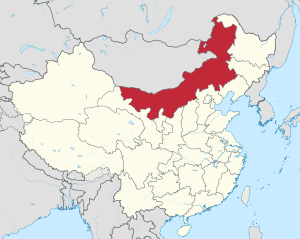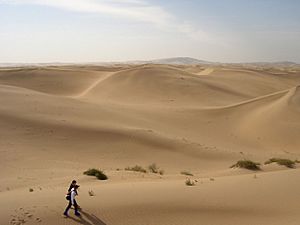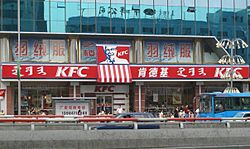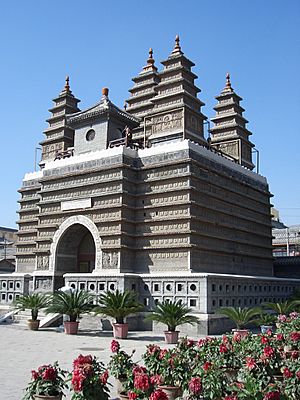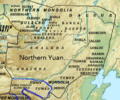Inner Mongolia facts for kids
Inner Mongolia (in Mongolian: Öbür mongγul; in Chinese: 内蒙古, Nèi Měnggǔ) is a special region in northern China. It is called an "autonomous region" because it has its own government that makes some decisions for the Mongol people living there.
Inner Mongolia shares borders with many Chinese provinces like Heilongjiang and Gansu. To its north, it borders the country of Mongolia and Russia. It's a huge area, the third largest in China, covering about 12% of the country's land. Around 24 million people live here. The capital city is Hohhot.
Most people in Inner Mongolia are Han Chinese. However, there is a large group of Mongols too. The main languages spoken are Standard Mandarin and Mongolian. Mongolian is written using a special classical alphabet.
Contents
What's in a Name?
In Chinese, this region is called "Inner Mongolia." The words "Inner" and "Outer" come from the Manchu language. "Inner Mongolia" is different from "Outer Mongolia." "Outer Mongolia" was a name used for what is now the independent country of Mongolia and also the Republic of Tuva in Russia.
In Mongolian, the region is known as öbör mongγol. The word öbör can mean south, inner, front, or even bosom.
Who Lives in Inner Mongolia?
The largest group of people living in Inner Mongolia are the Han Chinese, making up about 80% of everyone. The Mongols are the second largest group, about 17% of the population. Interestingly, more Mongols live in Inner Mongolia than in the independent country of Mongolia!
Here's a look at the different groups from a 2000 study:
| Main Groups in Inner Mongolia (2000) | ||
|---|---|---|
| Group | Number of People | Percentage |
| Han Chinese | 18,465,586 | 79.17% |
| Mongol | 3,995,349 | 17.13% |
| Manchu | 499,911 | 2.14% |
| Hui | 209,850 | 0.900% |
| Daur | 77,188 | 0.331% |
| Evenks | 26,201 | 0.112% |
| Koreans | 21,859 | 0.094% |
| Russians | 5,020 | 0.022% |
Fun Places to Visit
Inner Mongolia has many interesting places to explore, from ancient temples to vast grasslands.
Exploring Hohhot
In the capital city of Hohhot, you can find:
- Dazhao Temple: This is a Lamaist temple built in 1580. It's famous for a statue of Buddha made of silver, amazing dragon carvings, and beautiful murals.
- Xiaozhao Temple: Also known as Chongfu temple, this Lamaist temple was built in 1697. The Qing Dynasty emperor Kangxi liked it very much.
- Xilituzhao Temple: This is the biggest Lamaist temple in the Hohhot area. It used to be a very important center for Tibetan Buddhism in the region.
- Zhaojun Tomb: This is the tomb of Wang Zhaojun. She was a lady from the Han Dynasty palace who became a wife of a Xiongnu ruler.
Adventures Outside the Capital
Beyond Hohhot, there are more amazing sights:
- Mausoleum of Genghis Khan: This is a special monument for Genghis Khan, a famous Mongol leader. It's located in Ordos City.
- Bashang Grasslands: Close to Beijing, these grasslands are a popular spot for city people to enjoy nature and experience grassland life.
- Arshihaty Stone Forest: This UNESCO Geo Park has incredible granite rock shapes. They were formed over time by natural erosion.
- Xiangshawan: Also called "singing sands gorge," this place is in the Gobi Desert. You can try sand sledding or ride camels here!
Images for kids
-
A Persian miniature showing Genghis Khan entering Beijing
-
Inner Mongolia and Outer Mongolia within the Qing dynasty, around 1820
-
A theater in Hohhot
-
The Temple of the White Sulde of Genghis Khan in Uxin, Inner Mongolia. Both Chinese and Mongolian folk religions honor Genghis Khan here.
-
A fresco from a Liao dynasty (907–1125) tomb at Baoshan, Ar Horqin Banner
-
Khitan people cooking. This fresco is from a Liao dynasty (907–1125) tomb in Aohan Banner
-
A model of the Maidari Juu temple fortress (美岱召) built by Altan Khan in 1575 near Baotou
-
Dazhao temple (also called Ikh Zuu) built by Altan Khan in 1579
See also
 In Spanish: Mongolia Interior para niños
In Spanish: Mongolia Interior para niños


